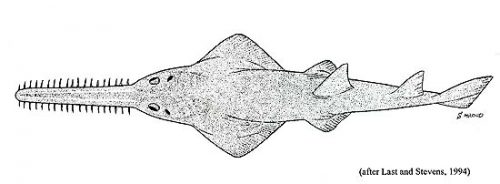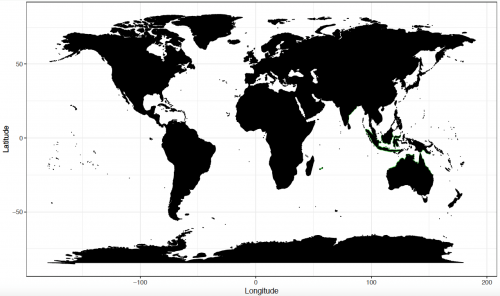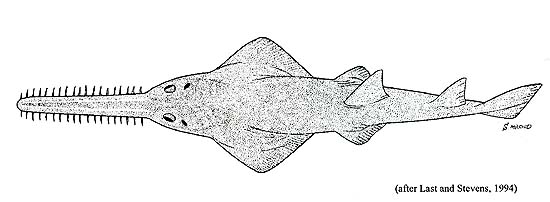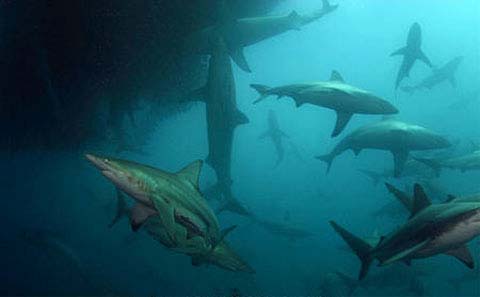Dwarf Sawfish

Pristis clavata
Although sawfish look like sharks, they are actually highly modified rays. The rostral ‘teeth’ are specialized denticles. The dwarf sawfish is the smallest sawfish species, reaching 3.1 m (10 ft). Very little is known about its behavior.
Order – Rhinopristiformes
Family – Pristidae
Genus – Pristis
Species – clavata
Common Names
English: Queensland sawfish
Czech: piloun trpaslici
Dutch: dwergzaagrog
Importance to Humans
Dwarf sawfish are occasionally caught in commercial gillnet and trawl fisheries targeting other species, but are not specifically targeted by any legal industries (Last et al., 2016). Like all sawfishes, their fins are sold in the Asian ‘shark fin’ market, their livers processed for oil, and skins made into leather. The eggs, liver oil, rostra, and bile are used in Chinese traditional medicine. Their rostra are also marketed as religious offerings, and curios (Guilford, 2014).
Danger to Humans
All sawfishes are harmless to humans if left undisturbed. Humans are too large to be viewed as potential prey. Care must be taken when handling or approaching a sawfish of any size, as they may defend themselves when they feel threatened, using their powerful saw to strike from side to side.
Conservation
IUCN Red List Status: Endangered
Evidence suggests P. clavata may have the smallest range of any sawfish, being “possibly extinct” outside of Australia. The International Union for Conservation of Nature and Natural Recourses (IUCN) Red List of Threatened Species has categorized the species as “Endangered” because of its increasing rarity. Dwarf sawfish are protected in Australia under the Environment Protection and Biodiversity Conservation Act 1999; Fisheries Act 1994 (In Queensland); Territory Parks and Wildlife Conservation Act 2000 (Northern Territory); Fish Resources Management Act 1994 (Western Australia). International trade of all sawfish are banned in the Convention on International Trade in Endangered Species (CITES). Evidence for their decline, whether anthropomorphic or natural, is unclear; however, the biggest threat to the dwarf sawfish is habitat degradation, pollution and bycatch in commercial gillnet and trawl fisheries (Stevens et al., 2005). Australia has implemented specific management practices to counteract this decline through education on safe release practices, and fishery-specific management.
> Check the status of the dwarf sawfish at the IUCN website.
Geographical Distribution

Dwarf sawfish can be found from the Pilbara coast of northwestern Australia to the Kimberley region and the Gulf of Carpentaria, Queensland (Compagno and Last 1999, Last and Stevens 2009). P. clavata was historically found in New Guinea, Indonesia, and Malaysia, though their complete historical distribution is not known. An unconfirmed record in Arabian Peninsula exists, but little evidence is available to substantiate the claim.
View reported sawfish encounters on a world mapHabitat
Dwarf sawfish occur in coastal areas, estuaries, mangrove swamps, and rivers, preferring sand and mud flats (Last et al., 2016). Being found in shallow water (0.7- 20 m) ranging from 1–41 ppt in salinity (Thorburn et al. 2008; Stevens et al., 2008). P. clavata has been recorded in the Pentecost River, Western Australia, as far as 6.2 miles (10 km) upstream, and in the adjacent estuary.
Biology

Distinctive Features
The head is ventrally flattened with the mouth and gills located underneath and eyes positioned dorsally. Sawfish are able to breathe while lying on the ocean floor by drawing water into their gills through large holes behind each eye, called spiracles. Their most distinctive feature is their long flat rostral “saw” – studded with rostral teeth along the margins. These “teeth” are set deeply in hard cartilage and do not grow back if the root is damaged.
| Common Name | Scientific Name | Rostral Tooth Count | Distribution | Other Distinguishing Features |
| Smalltooth sawfish | Pristis pectinata | 20-30 | Atlantic Ocean | common off the coasts of Florida |
| Largetooth sawfish | Pristis pristis | 14-24 | Global | teeth evenly spaced; rostrum wide |
| Green sawfish | Pristis zijsron | 23-37 | Indo-West Pacific Ocean | green in color |
| Dwarf Sawfish | Pristis clavata | 18-24 | Indo-West Pacific Ocean | teeth evenly spaced; rostrum short and wide |
| Knifetooth Sawfish | Anoxypristis cuspidata | 16-26 | West Pacific Ocean | rostral teeth missing at the base of rostrum |
Dwarf sawfish can be easily distinguished from other sawfish by its size and rostral teeth count and orientation (See table) (Last et al., 2016).
Coloration
The dorsal body surface is olive-brown in color, darker on the head, and fading to a white or yellow ventrally. The fins are often lighter in color than the dorsal body surface (Last et al., 2016).
Dentition
Oral dentition is similar in both jaws, exhibiting many rows of blunt teeth with rounded cusps and smooth surfaces. Teeth show wear from use, which may be particularly noticeable towards the symphysis (medial junction of each jaw) along the front series of tooth rows.
Dermal Denticles
Dermal denticles are flat, with a rounded crown. Denticles are similar in all development stages, although larger individuals exhibit a more pronounced crown than young. Along the posterior portion of the body denticles are more elongate and convex. Versus the ventral body surface where denticles are smaller and positioned in a pavement-like pattern (Deynat, 2005).
Size, Age & Growth
Dwarf sawfish can grow to 310 cm (10 ft.). Young are 60-81 (2-2.5 ft.) cm at birth, reaching maturity between 255–260 cm (8.5 ft.) (males) (Peverell, 2005; Peverell, 2008; Stevens, et al., 2008; Last and Stevens, 2009; Morgan, et al., 2011). The species is estimated to live 34 years (Peverell, 2008).
Food Habits
Sawfish use their rostrum in a side-to-side slashing motion to dislodge invertebrates from substrate and to stun schooling fishes. Little is known about the feeding habits of this species. Probable prey include small fishes and crustaceans (Last et al., 2016).
Reproduction
Embryos are nourished only by a yolk sac, which provides energy in utero. The yolk is fully absorbed before the young sawfish are born (Stevens et al., 2005). The gestation period is not known, but the largetooth sawfish (Pristis pristis) has a gestation of about five months. The young are probably born tail-first, with their saw covered in a sheath of tissue until after birth, so as not to injure the mother (Walker, 2003; FSUCML. 2016). Dwarf sawfish give birth during the northern Australian wet season (roughly November to April) (Peverell 2005). Litter size remains unknown (Last and Stevens 2009), but the young are thought to live in estuarine waters for the first 3 years of life (Thorburn et al. 2008).

Predators
Predator attacks on dwarf sawfish have not been documented, but likely predators include hammerhead sharks (Sphyrna spp.), bull sharks (Carcharhinus leucas), copper sharks (Carcharhinus brachyurus), and saltwater crocodiles (Crocodylus porosus).
Parasites
Neoheterocotyle darwinensis lives within the gills of the dwarf sawfish, and is known to occur near Darwin, Australia. Other species likely to use the dwarf sawfish as a host include Nonacotyle pristis, a species known to inhabit the gills of the freshwater sawfish. Monogenean helminths such as Erpocotyle caribbensis and Pristonchocotyle intermedia, both inhabit the gills of largetooth sawfish in Central America, and the cestode helminths Phyllobothrium pristis and Anthobothrium pristis, both inhabit the spiral valve of largetooth sawfish in Central America. Other potential parasites include copepods, nematodes, protozoans, and trematodes. Areas of parasite inhabitation may include the skin, gills, and digestive tract.
Taxonomy
The dwarf sawfish was first described in 1906 by Samuel Garman, a legendary anatomist and the first official curator of fishes, amphibians, and reptiles at the Museum of Comparative Zoölogy (MCZ) at Harvard. A male dwarf sawfish measuring 24.4 inches (61.9 cm) in total length from Queensland, Australia was deposited and cataloged at the MCZ in October of 1877. This specimen remains as a representative example (termed ‘type specimen’) of the species. Due to copper staining, this specimen is slightly green in color. This discoloration may have caused Garman to describe his new species as olive-green in color (sawfishes are normally brown or tan in color). Garman later illustrated this specimen in his famous 1913 monograph entitled The Plagiostomia. The valid scientific name for the dwarf sawfish is Pristis clavata Garman, 1906. Synonyms include Pristis pectinata Latham, 1794 and Pristis pristis (Linnaeus, 1758), both are misidentifications. The generic name Pristis is Greek for “saw”. The specific name clavata is derived from the Latin word clava meaning “club”.
References
Compagno, L.J.V. and Last, P.R. 1999. Family Pristidae. Sawfishes. In: Carpenter, K.E. and Niem, V.H. (eds), The Living Marine Resources of the Western Central Pacific. Volume 3 Batoid Fishes, Chimaeras and Bony Fishes Part 1 (Elopidae to Linophrynidae). FAO Species Identification Guide for Fishery Purposes, FAO, Rome.
Department of Sustainability, Environment, Water, Population and Communities (DSEWPaC). 2011. Draft issues paper for freshwater sawfish (Pristis microdon), green sawfish (Pristis zijsron), dwarf sawfish (Pristis clavata), speartooth shark (Glyphis glyphis) and northern river shark (Glyphis garracki). Department of Sustainability, Environment, Water, Population and Communities, Canberra.
Deynat, P.P., 2005. New data on the systematics and interrelationships of sawfishes (Elasmobranchii, Batoidea, Pristiformes). Journal of Fish Biology, 66(5), pp.1447-1458.
Dulvy, N.K., Davidson, L.N., Kyne, P.M., Simpfendorfer, C.A., Harrison, L.R., Carlson, J.K. and Fordham, S.V. 2016. Ghosts of the coast: global extinction risk and conservation of sawfishes. Aquatic Conservation: Marine and Freshwater Ecosystems, 26(1), pp.134-153.
FSUCML. 2016. FSUCML scores another scientific first: Dr. Dean Grubbs and colleagues document and assist pregnant sawfish give birth in the wild. Florida State University, Coastal and Marine Laboratory.
Guilford, Gwynn. 2014. Fishing, Chinese Medicine, and a Crazy-Looking Snout Are Driving Sawfish to Extinction. Quartz, qz.com/217333/fishing-chinese-medicine-and-a-crazy-looking-snout-are-driving-sawfish-to-extinction/.
Last, P.R. and Stevens, J.D. 2009. Sharks and Rays of Australia. Second Edition. CSIRO Publishing, Collingwood, Australia.
Last, P., Naylor, G., Séret, B., White, W., de Carvalho, M. and Stehmann, M. eds. 2016. Rays of the World. Csiro Publishing.
Morgan, D.L., Whitty, J.M., Phillips, N.M., Thorburn, D.C., Chaplin, J.A. and McAuley, R. 2011. North-western Australia as a hotspot for endangered elasmobranchs with particular reference to sawfishes and the northern river shark. Journal of the Royal Society of Western Australia 94: 345-358.
Peverell, S.C. 2005. Distribution of sawfishes (Pristidae) in the Queensland Gulf of Carpentaria, Australia, with notes on sawfish ecology. Environmental Biology of Fishes 73: 391-402.
Peverell, S. C. 2008. Sawfish (Pristidae) of the Gulf of Carpentaria, Queensland, Australia. School of Marine Biology, James Cook University.
Stevens, J.D., Pillans, R.D. and Salini, J. 2005. Conservation assessment of Glyphis sp. A (speartooth shark), Glyphis sp. C (northern river shark), Pristis microdon (freshwater sawfish) and Pristis zijsron (green sawfish). Final Report to the Department of the Environment and Heritage.
Stevens, J.D., McAuley, R.B., Simpfendorfer, C.A. and Pillans, R.D. 2008. Spatial distribution and habitat utilisation of sawfish (Pristis spp) in relation to fishing in northern Australia. A report to Department of the Environment, Water, Heritage and the Arts.
Thorburn, D.C., Morgan, D.L., Rowland, A.J., Gill, H.S. and Paling, E. 2008. Life history notes of the Critically Endangered dwarf sawfish, Pristis clavata, Garman 1906 from the Kimberley region of Western Australia. Environmental Biology of Fishes 83: 139-145.
Walker, S.M. 2003. Rays. Carolrhoda Books, Inc. p. 38. ISBN 1-57505-172-9.